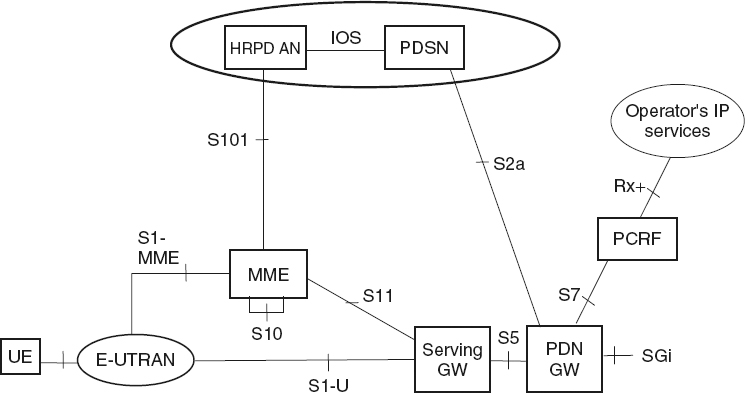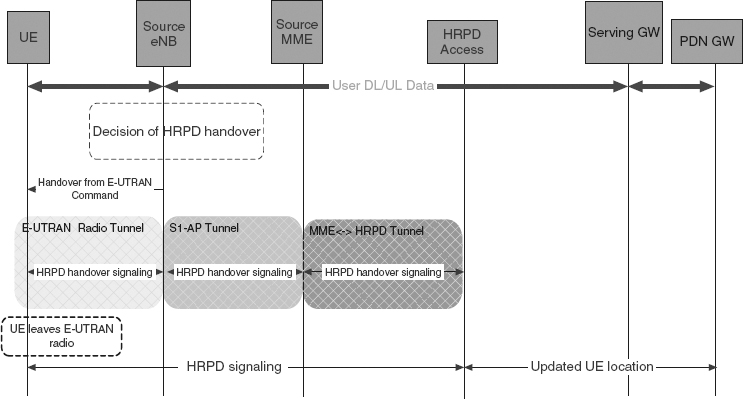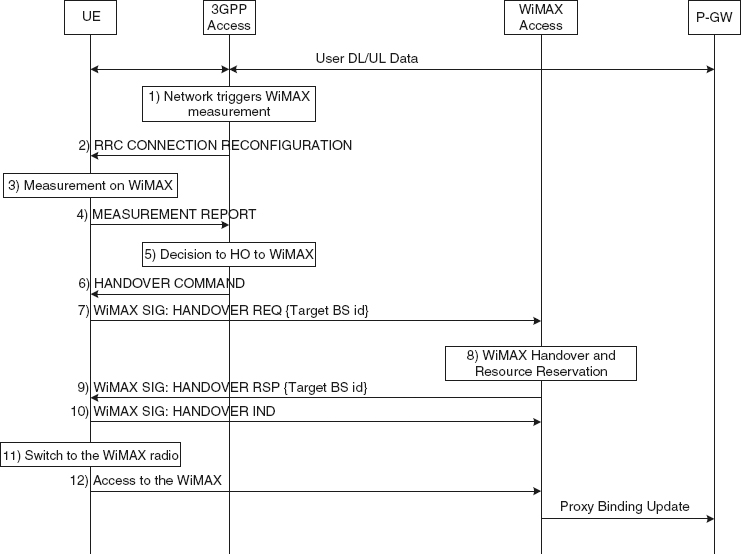Inter-Technology Access
Inter-radio access technology is the ability to support the mobility of a user device between differing radio access network types, also known as vertical handovers. Inter-radio access between heterogeneous networks is important to be executed properly for seamless communication with minimum delay and packet loss to disassociate from the current serving BS to associate to the new BS. LTE defines two types of inter-radio technologies: inter- technology access between LTE to legacy 3GPP systems, also known as inter-radio access technology (inter-RAT) and inter- technology access between LTE and other non-3GPP systems.
Inter-technology access can be supported using different techniques. The most primitive one is the mobility from one technology to another without the intervention of the network. In this case the device is equipped with different technology interfaces. The user or the device selects which technology to access and associate to the corresponding network. Once this network becomes unavailable, the user or the device selects another technology and associate with. This type of inter-technology handover is acceptable for delay-tolerant and low QoS requirement applications such as http and e-mail. However, delay-intolerant or session based applications cannot tolerate the service interruption and may require re-initiation of the session including the re-authentication process. A more efficient inter-technology mobility for session based applications is one that supports the data session continuity across multiple technologies. In this type of mobility, session continuity is preserved while the user moves across different technologies. Association to a new technology and disassociation from a serving one is accomplished with no user actions and it is transparent to the applications. Hence, re-authentication by users or data interruption has no impact in this type of mobility.
Approaches to Inter-Technology Mobility
Different approaches are used to provide inter-technology mobility with session continuity [5]. We discuss three general approaches in this section:
Single Transmit Device: Mobile IP (MIP) is standardized by the IETF to support for the session continuity at the IP layer. Hence, cannot support user authentication and login while moving across the different technologies. Single transmit device- MIP based approach makes use of the MIP service and hence it is a single transmit device, the device is only capable to associate with one technology at a time. In other words, it needs to disassociate from the serving technology before associating to the target technology. Despite the simplicity of this type, it suffers from a large delay associated with the signaling needed to associate and authenticate with the target technology. The type of inter-technology handover is known as non-optimized inter-technology handover. 3GPP standard use this approach to support inter-technology mobility between WiMAX and LTE and between EVDO and LTE. Optimized inter-technology handover is defined in LTE as the inter-technology handover which allows/requires the serving technology exchanging control data and signaling messages with the target technology as described in the following approach. The optimized handover is expected to support delay-stringent applications such as VoIP.
Access Network Interconnect: This approach is used mainly in networks managed by single operator and employ technology with different generations but similar origin (newer technology that supports backward compatibility with older generations) such as CDMA2000 and EVDO or UMTS and GSM. The access network interconnect requires the serving and the target networks to be physically connected to facilitate the handover process and exchange the signaling messages (optimized handover). Access network interconnect is limited to the technologies produced by the same standardization body, however, 3GPP with collaboration with 3GPP2 defined procedures to extend this approach to EVDO. 3GPP and IEEE 802.16 working group are in the process in investigating optimized handover between LTE and WiMAX.
Dual-Transmit Devices (DTD) based inter-technology handover: This type of mobility does not require the serving technology to be connected to the target technology, since the user device is involved in the initiation and termination of the connection to the technology. It is realized by two types of services, Mobile IP (MIP) and Session Initiation Protocol (SIP).
MIP: In this type, since the device is equipped with dual transmitters, the device during handover employs make-before-brake handover. The device while it is connected to its serving technology uses its second transmitter to connect to the target technology, hence maintaining its data session and preventing data loss. Once the association process is completed with the target technology, the device uses the MIP service to move the data session to the target network. Examples are the inter-technology handover between LTE and WiFi and EVDO and WiMAX.
SIP: This solution is suitable for inter-device inter-technology mobility where a data session is required to be moved not only between technologies but also between devices. This is the only solution to support inter-device mobility. However, it is only applicable for SIP based applications. An example of this type of mobility is the standardization of LTE-Advanced which is expected to support inter-device and inter-technology mobility based on SIP and IMS.
Examples of Inter-Technology Access
Inter-RAN Between LTE and CDMA2000
We present in this subsection, the support of the mobility between LTE and CDMA2000 as an example of the Inter-technology access between 3GPP2 and LTE system. Figure 16.2 shows the network architecture support for the mobility between CDMA2000 and LTE, and Figure 16.3 shows the procedure for the handover between LTE and CDMA2000.

Figure 16.2 Architecture for optimized handover between mobile WiMAX and 3GPP2.

Figure 16.3 Handover procedure from LTE to CDMA2000.
A UE is attached to the EUTRAN network. Based on measurement reports received from the UE, the eNB initiates a handover by sending a “Handover from EUTRAN Command” message to the UE to indicate that the UE should begin the handover procedure. The message includes the specified target type and any specified parameters needed by the UE to create the appropriate messages needed to request a connection from the CDMA2000 network. The UE continues to send and receive data on the EUTRAN radio until it receives the “handover command” ordering it to switch to the target CDMA2000 cell. After the “handover command” is received by the UE, it leaves the EUTRAN radio and start acquiring the CDMA2000 traffic channel. When the UE receives the CDMA2000-HRPD Traffic Channel Assignment Message (tunneled over the EUTRAN), it leaves the EUTRAN radio and perform its access over the CDMA2000-HRPD radio.

Figure 16.4 Architecture for optimized handover between mobile WiMAX and 3GPP using L2 Tunneling.
Figure 16.4 shows the reference architecture for optimized handovers between mobile WiMAX and 3GPP access using L2 tunneling between MME and WiMAX ASN. This architecture uses the EPC network elements and reference points which are already specified. It does not require any changes on these network elements and reference points. All the interfaces and network entities that separate SAE/LTE from WiMAX ASN are defined in [4]. Interface S101 enables interaction between EPS and WiMAX ASN access to allow for handover signaling.
Inter-RAN Between LTE and WiMAX
LTE release 9 defines the procedure for optimized LTE to WiMAX handover. The following steps show the procedure for a UE to move from an LTE network to a WiMAX as presented in [6]. These steps are shown in Figure 16.5.
Based on the Measurement Report received from the UE, EUTRAN may trigger the UE to perform WiMAX measurements. Configurations for WiMAX measurements and measurement reports are sent to the UE. This latter performs measurement on the WiMAX based on the received WiMAX measurement configuration. Next, it sends Measurement Report based on the received WiMAX measurement reporting configuration. Based on the Measurement Report received from the UE, EUTRAN may decide handover to the WiMAX for the UE. EUTRAN may also decide handover based on RRM information.

Figure 16.5 Optimized EUTRAN to WiMAX Handover.
EUTRAN instructs the UE to initiate handover to the WiMAX by Handover Command. EUTRAN can inform whether optimized handover is supported or not. If optimized handover is supported, steps 7–12 will be followed. If optimized handover is not supported, after the reception of the Handover Command, the UE will leave the 3GPP radio access, switch to the WiMAX radio access, and perform WiMAX specific handover procedure. The UE initiates the handover to the WiMAX by tunneling a WiMAX Handover Req. message including the target WiMAX BS ID. Resources are reserved in the target WiMAX. The WiMAX sends a WiMAX Handover Rsp. message including the target WiMAX BS ID. The UE notifies the WiMAX that it starts handover to the indicated WiMAX BS by tunneling a WiMAX Handover Ind. message.
The UE leaves the 3GPP radio access and switches to the WiMAX radio access. The UE performs the WiMAX specific access procedure.
